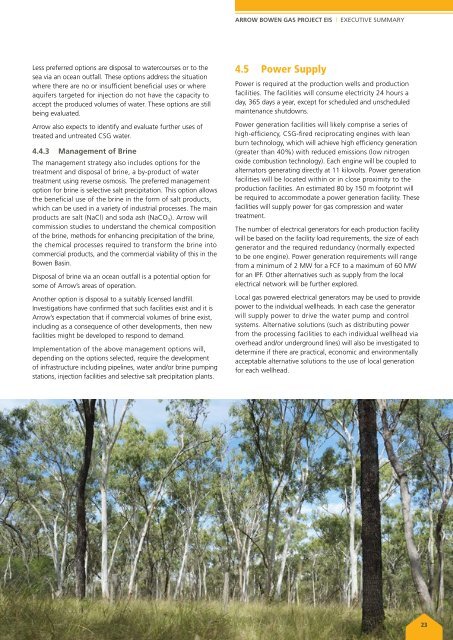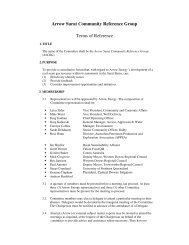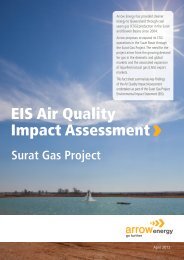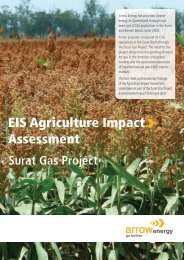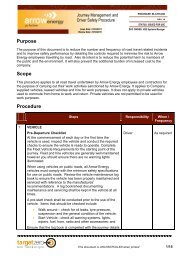Arrow Bowen GAs Project - Arrow Energy
Arrow Bowen GAs Project - Arrow Energy
Arrow Bowen GAs Project - Arrow Energy
You also want an ePaper? Increase the reach of your titles
YUMPU automatically turns print PDFs into web optimized ePapers that Google loves.
<strong>Arrow</strong> <strong>Bowen</strong> Gas <strong>Project</strong> EIS | Executive summary<br />
Less preferred options are disposal to watercourses or to the<br />
sea via an ocean outfall. These options address the situation<br />
where there are no or insufficient beneficial uses or where<br />
aquifers targeted for injection do not have the capacity to<br />
accept the produced volumes of water. These options are still<br />
being evaluated.<br />
<strong>Arrow</strong> also expects to identify and evaluate further uses of<br />
treated and untreated CSG water.<br />
4.4.3 Management of Brine<br />
The management strategy also includes options for the<br />
treatment and disposal of brine, a by-product of water<br />
treatment using reverse osmosis. The preferred management<br />
option for brine is selective salt precipitation. This option allows<br />
the beneficial use of the brine in the form of salt products,<br />
which can be used in a variety of industrial processes. The main<br />
products are salt (NaCl) and soda ash (NaCO 3 ). <strong>Arrow</strong> will<br />
commission studies to understand the chemical composition<br />
of the brine, methods for enhancing precipitation of the brine,<br />
the chemical processes required to transform the brine into<br />
commercial products, and the commercial viability of this in the<br />
<strong>Bowen</strong> Basin.<br />
Disposal of brine via an ocean outfall is a potential option for<br />
some of <strong>Arrow</strong>’s areas of operation.<br />
Another option is disposal to a suitably licensed landfill.<br />
Investigations have confirmed that such facilities exist and it is<br />
<strong>Arrow</strong>’s expectation that if commercial volumes of brine exist,<br />
including as a consequence of other developments, then new<br />
facilities might be developed to respond to demand.<br />
Implementation of the above management options will,<br />
depending on the options selected, require the development<br />
of infrastructure including pipelines, water and/or brine pumping<br />
stations, injection facilities and selective salt precipitation plants.<br />
4.5 Power Supply<br />
Power is required at the production wells and production<br />
facilities. The facilities will consume electricity 24 hours a<br />
day, 365 days a year, except for scheduled and unscheduled<br />
maintenance shutdowns.<br />
Power generation facilities will likely comprise a series of<br />
high-efficiency, CSG-fired reciprocating engines with lean<br />
burn technology, which will achieve high efficiency generation<br />
(greater than 40%) with reduced emissions (low nitrogen<br />
oxide combustion technology). Each engine will be coupled to<br />
alternators generating directly at 11 kilovolts. Power generation<br />
facilities will be located within or in close proximity to the<br />
production facilities. An estimated 80 by 150 m footprint will<br />
be required to accommodate a power generation facility. These<br />
facilities will supply power for gas compression and water<br />
treatment.<br />
The number of electrical generators for each production facility<br />
will be based on the facility load requirements, the size of each<br />
generator and the required redundancy (normally expected<br />
to be one engine). Power generation requirements will range<br />
from a minimum of 2 MW for a FCF to a maximum of 60 MW<br />
for an IPF. Other alternatives such as supply from the local<br />
electrical network will be further explored.<br />
Local gas powered electrical generators may be used to provide<br />
power to the individual wellheads. In each case the generator<br />
will supply power to drive the water pump and control<br />
systems. Alternative solutions (such as distributing power<br />
from the processing facilities to each individual wellhead via<br />
overhead and/or underground lines) will also be investigated to<br />
determine if there are practical, economic and environmentally<br />
acceptable alternative solutions to the use of local generation<br />
for each wellhead.<br />
23


